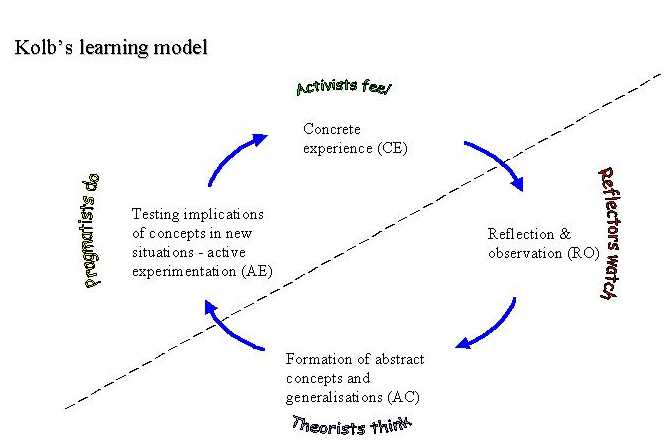
|
Kolb's
learning styles inventory
|
Learning theory
Kolb's model of the learning process suggests a four-phase cycle of learning, and four modes of learning, characterised here by the terms activists, reflectors, theorists and pragmatists.

We each have our individual learning styles, made up a mix of the above four modes. The dividing line in the diagram should help you understand, firstly the AC-CE balance (how much more inclined you are towards the abstract rather than concrete) and secondly the AE-RO balance (how much you are inclined towards active experimentation rather than reflective behaviour). Kolb et al stress that these exercises are not intended to be definitive, that each person's style is not necessarily fixed, and that in using them we should avoid the danger of stereotyping ourselves or others.
The learning style profile diagram (page 16 of the workbook) shows the extent you are inclined towards each of the four different learning styles, whereas the learning style type grid (on page 18 of the workbok) shows your AC-CE balance and AE-RO balance all at once. You could think of your point on this grid on page 18 as portraying the "centre of gravity" of the diagram on page 16.
The exercise
that follows requires you to plot yourself on the types grid along with
other students in your group.
Here is the exercise you are asked to carry out as a group within workshop 2 to plot yourself and other students on a "floor map" version of Kolb's learning style type grid. This page is based entirely on a section from Kolb et al's book - the full reference is at the end of this document. Note that "Step 1" has been omitted; this represents the individual preparation you should have done before the workshop, as defined at the end of the outline for workshop 1.
STEP 2: Portray the learning styles of class members (10 minutes)
a. Using masking tape, a learning style grid large enough for the entire class to stand on should be laid out on the floor of an open area
b. Individual group members should stand on this floor grid in the position corresponding to their X as positioned in individual preparation for the workshop
STEP 3: Individuals with similar learning styles join together in small groups of three to six (20 minutes)
a. Once the group members have positioned themselves on the spot that best indicates their learning style, they should form small groups, four to six persons with their nearest neighbours, ie those with similar learning styles
b. When this is completed, all members of these groups, in turn, should share with the group their thoughts on the following three topics:
1. Do your learning profile scores seem valid to you? How do you characterise the way in which you learn? Does your learning style profile relate to the way you went about the recent learning situation you described in the pre-workshop preparation?
2. What do you think is your greatest strength as a learner?
3. What do you think is your greatest weakness?
Other members of the group may ask questions as each person speaks; however, the group should budget its time so that all participants get a chance to share their thoughts on these questions.
STEP 4: Reports to the total group (25 minutes). A representative of each small group should briefly report to the total group:
a. Where they stood on the grid
b. The main points of their discussion - the content of the meeting
c. Observations about the process of their group meeting. How did it feel to be in a group of individuals who had learning styles similar to yours? Was the group's learning style reflected in the way the meeting ran? Do you prefer being in a group with similar or mixed learning styles?
d. What connection can you make between this exercise and the readings for today's class?